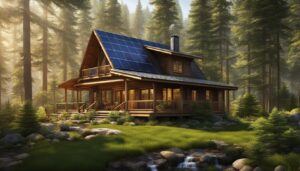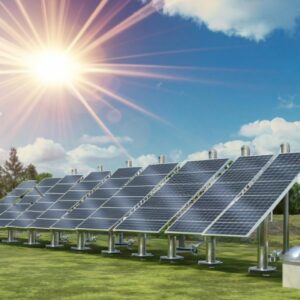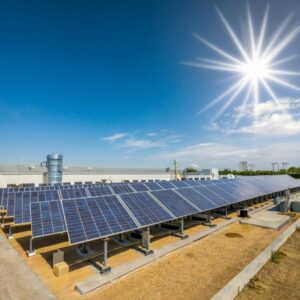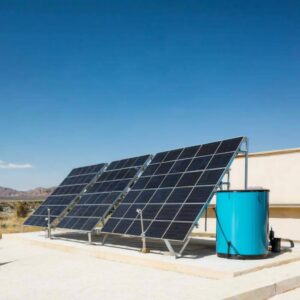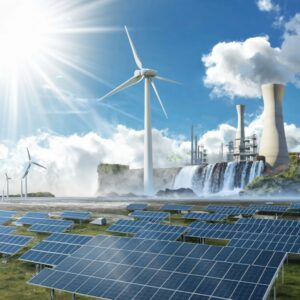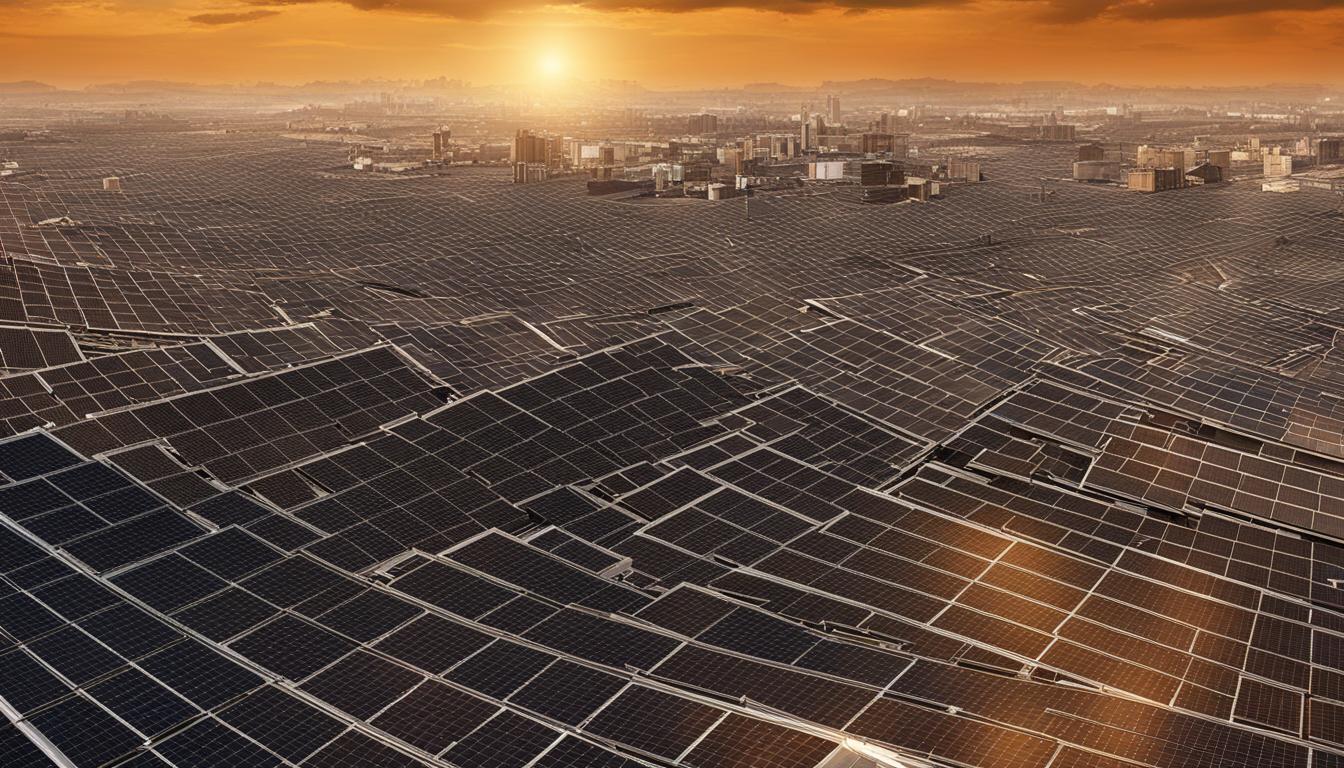
As a professional in the renewable energy industry, I am often asked about the viability of solar energy in urban settings. There seems to be a common misconception that limited space hinders the implementation of solar power. However, I am here to debunk these myths and shed light on the potential of solar energy in urban areas.
Solar energy is a clean, renewable source of power that holds immense potential for meeting the energy needs of urban communities. Despite the challenges posed by space constraints, innovative solutions and advancements in technology enable cities to make the most of solar energy.
Key Takeaways:
- Solar energy is a viable solution for urban settings, despite space limitations.
- Rooftop solar installations and integrated solar panels offer creative space utilization.
- Solar technology has evolved to be efficient in converting sunlight into energy.
- Solar energy can provide long-term cost savings through reduced utility bills and financing options.
- Advancements in energy storage systems ensure a consistent power supply in cloudy or low sunlight conditions.
Myth: Solar Panels Require Vast Open Spaces
One common myth about solar energy is that it requires vast open spaces. While large-scale solar farms do exist in rural areas, urban settings can also accommodate solar panels. Rooftop solar installations have become increasingly popular, allowing buildings to generate their own clean energy. Additionally, solar panels can be integrated into various structures such as parking lots, walkways, and even windows, maximizing the use of space.
Contrary to popular belief, solar panels can be efficiently utilized in urban environments, making it possible for individuals and businesses to contribute to a greener future. By capitalizing on existing structures and optimizing available space, solar power can be generated without the need for extensive open areas.
Maximizing Space Utilization with Solar Panels
Solar panels provide a versatile solution for maximizing space utilization in urban settings. Here are some examples:
- Rooftop Solar Installations: Buildings in urban areas have ample roof space that can be effectively utilized for installing solar panels. By harnessing the power of the sun, these rooftops can generate clean electricity, reducing reliance on traditional power sources. This approach not only maximizes space but also has the added benefit of reducing energy costs for building owners.
- Parking Lot Solar Canopies: Parking lots consume significant amounts of space in urban areas. However, by integrating solar panels into canopies above parking spaces, both shade and clean energy can be provided. These solar canopies not only generate electricity but also provide shelter for vehicles, ensuring a dual purpose for the space.
- Solar Walkways and Bike Paths: Urban landscapes often feature walkways and bike paths that connect various areas. By incorporating solar panels into these paths, sunlight can be harnessed to generate power while maintaining the functionality of the infrastructure. This innovative approach transforms open spaces into energy-generating assets, combining sustainability with urban design.
- Solar Windows: Solar technology has advanced to the point where transparent solar panels can be integrated into windows. This breakthrough allows buildings to generate electricity while still allowing natural light to enter the space. By utilizing windows as power-generating surfaces, urban areas can maximize space efficiency and reduce the overall environmental impact.
As urban populations continue to grow, the necessity for sustainable energy solutions becomes increasingly apparent. By dispelling the myth that solar panels require vast open spaces, we can encourage the widespread adoption of solar energy in urban environments. Embracing solar power not only helps combat climate change but also enhances the resilience and self-sufficiency of cities.
Next, we will address another common myth about solar energy: “Myth: Solar Panels Are Inefficient in Cloudy or Cold Climates.”
Myth: Solar Panels Are Inefficient in Cloudy or Cold Climates
One of the prevailing misconceptions about solar panels is that they are inefficient in cloudy or cold climates. However, this myth can be easily debunked. While it’s true that direct sunlight is ideal for optimal solar panel performance, it doesn’t mean that solar panels are rendered completely inefficient in unfavorable weather conditions.
In fact, even on overcast days, solar panels can still generate electricity. While the amount of electricity produced may be slightly reduced compared to sunny days, modern solar technology has advanced to be more efficient in converting sunlight into energy. This means that solar panels can continue to provide a reliable source of clean power, even in cloudy climates.
Additionally, solar panels can actually benefit from cold climates. In snowy regions, solar panels can take advantage of the reflection of sunlight off the snow, which can increase their efficiency. The panels can generate electricity not only from direct sunlight but also from the reflected sunlight, maximizing their performance in cold and snowy conditions.
“Solar panels are designed to capture and convert sunlight into electricity, which means they can still function in cloudy or cold climates.” – Dr. Sarah Thompson, Solar Energy Expert
It’s important to note that the efficiency of solar panels is not solely determined by the presence of intense sunlight. Advancements in technology and design have made solar panels more resilient and adaptable to different weather conditions, including cloudy and cold climates.
| Myth | Fact |
|---|---|
| Solar panels are inefficient in cloudy climates. | Solar panels can still generate electricity even in overcast conditions, although slightly reduced. |
| Solar panels are inefficient in cold climates. | Solar panels can benefit from the reflection of sunlight off snow, increasing their efficiency. |
Myth: Solar Energy Is Expensive and Not Cost-Effective
Many people believe that solar energy is expensive and not cost-effective. However, the cost of solar panels has significantly decreased over the years, making them more accessible. Additionally, solar energy can provide long-term cost savings by reducing utility bills and potentially generating revenue through net metering. With various financing options available, such as leasing and power purchase agreements, the upfront costs can be minimized.
Cost Reduction of Solar Panels
The perception that solar energy is expensive is outdated. Over the years, advancements in solar panel technology and increased manufacturing efficiency have led to a significant reduction in their cost. The price of solar panels has declined by more than 70% since the early 2000s, making them a much more affordable option for homeowners and businesses alike. This cost reduction has made solar energy a financially viable choice for many.
Long-Term Cost Savings
While the upfront cost of installing a solar energy system may seem expensive, it is important to consider the long-term cost savings it can bring. By utilizing solar power, households and businesses can reduce their reliance on traditional energy sources, resulting in lower utility bills. The savings can be substantial over time, offsetting the initial investment. Moreover, in some regions, net metering allows solar energy system owners to sell excess electricity back to the grid, further offsetting their costs and even generating revenue.
Finance Options
To make solar energy even more accessible, various financing options are available. Leasing allows homeowners and businesses to install solar panels with little to no upfront cost, paying only a monthly lease payment. Power purchase agreements (PPAs) enable customers to purchase the electricity generated by a solar energy system at a predetermined rate, typically lower than utility rates. These financing options minimize the upfront expenses associated with solar panel installation, making it a more attractive and cost-effective option.
Thus, the belief that solar energy is expensive and not cost-effective is a misconception. The decrease in the cost of solar panels, along with long-term cost savings and innovative financing options, make solar energy a viable and financially beneficial choice for both individuals and businesses.
Myth: Solar Energy Is Unreliable and Intermittent
A common myth surrounding solar energy is its perceived unreliability and intermittency. While it is true that solar power generation depends on sunlight, significant advancements in energy storage systems have effectively addressed this concern.
Battery storage technology has emerged as a game-changer in overcoming the intermittent nature of solar energy. Excess energy produced during times of optimal sunlight can now be stored in batteries for later use, ensuring a consistent power supply even during periods of low sunlight. This breakthrough has transformed solar power into a reliable and dependable source of energy.
Furthermore, grid-tied systems provide an additional layer of reliability. These systems are designed to seamlessly switch to traditional power sources, such as the electrical grid, when solar energy production is insufficient to meet demand. This integration with conventional power sources guarantees a stable electricity supply regardless of the availability of sunlight.
“Thanks to advancements in energy storage systems and grid integration, the unreliability and intermittency concerns surrounding solar energy have been effectively addressed.”
The notion that solar energy is unreliable and intermittent is simply a misconception. With innovative storage solutions and grid integration, solar power has become a consistent and dependable energy option, even in situations with limited sunlight.
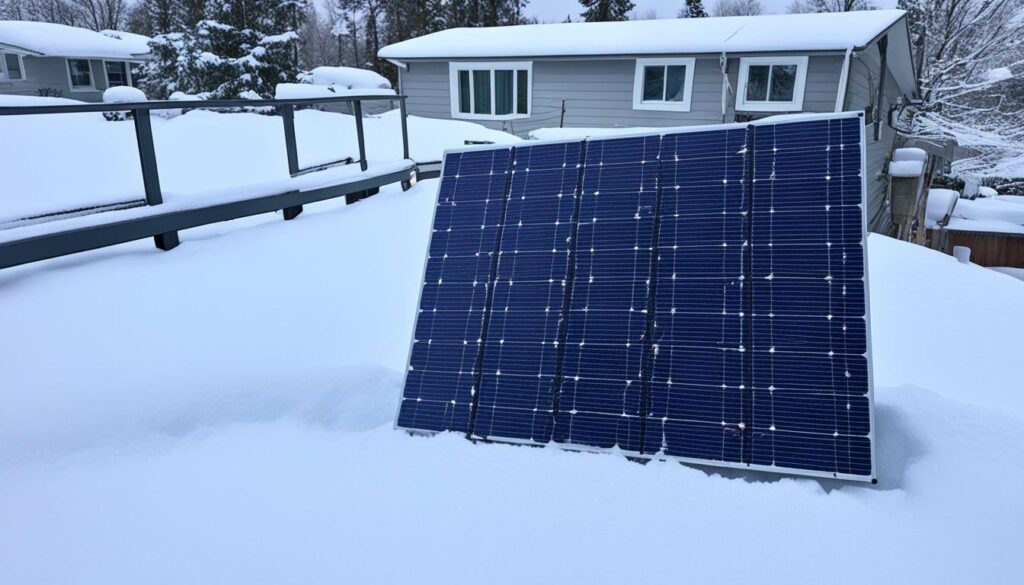
As shown in the image above, solar energy can now be stored in batteries, ensuring a continuous power supply even during periods of low sunlight. This advancement has made solar energy a reliable and viable option for meeting electricity demands.
Myth: Solar Energy Is Harmful to the Environment
Some people believe that solar energy is harmful to the environment. However, this is a misconception. Solar power is one of the cleanest sources of energy available, with minimal environmental impact compared to fossil fuels.
Solar energy does not produce any greenhouse gas emissions, which are known to contribute to climate change. Unlike traditional energy sources such as coal and natural gas, solar power generation does not release harmful pollutants into the atmosphere.
The manufacturing and installation processes of solar panels have also improved over the years, with a focus on sustainable practices and materials. Solar panels are primarily made from silicon, a non-toxic and abundant element found in sand. The use of sustainable materials and energy-efficient manufacturing techniques reduces the overall environmental impact of solar energy.
“Solar power is a clean and sustainable source of energy that plays a crucial role in reducing our dependence on fossil fuels and mitigating climate change,” says Dr. Emily Green, a renowned environmental scientist.
Furthermore, solar energy contributes to the preservation of natural resources. By harnessing the power of the sun, we can reduce our reliance on non-renewable resources such as coal, oil, and natural gas. This helps to conserve these valuable resources for future generations.

Advantages of Solar Energy for the Environment:
- Reduces greenhouse gas emissions
- Minimizes air and water pollution
- Conserves natural resources
- Helps combat climate change
- Promotes a sustainable and greener future
It is important to note that while solar energy is environmentally friendly, proper disposal and recycling of solar panels at the end of their lifespan are essential to minimize any potential environmental impact.
In conclusion, solar energy is a clean and sustainable source of power that is not harmful to the environment. Through its widespread adoption, we can significantly reduce greenhouse gas emissions, combat climate change, and create a healthier and more sustainable planet for future generations.
Conclusion
In conclusion, the common myths surrounding solar energy in urban settings have been debunked. It is evident that solar power can be effectively harnessed in urban areas, despite the space limitations. By dispelling these misconceptions, we can promote the adoption of solar energy as a sustainable solution for our energy needs.
With advancements in technology, such as rooftop solar installations and innovative space utilization techniques, urban settings can tap into the abundant solar energy available. This not only helps to reduce dependence on fossil fuels but also contributes to a greener and more sustainable future for our cities.
Furthermore, the cost-effectiveness of solar energy has significantly improved. The decreasing cost of solar panels, coupled with various financing options, makes solar power accessible to a wider range of urban dwellers. By investing in solar energy, individuals and businesses can save on utility bills and even generate revenue through net metering.
By embracing solar power in urban settings, we can effectively combat climate change and reduce our carbon footprint. Solar energy is a clean and renewable source of power that holds immense potential to transform our cities into sustainable and environmentally-friendly urban spaces. It’s time to debunk the common myths and embrace the true potential of solar energy in our urban settings.
FAQ
Do solar panels require vast open spaces?
No, solar panels can be installed on rooftops and integrated into various structures such as parking lots, walkways, and windows, maximizing the use of space in urban settings.
Are solar panels inefficient in cloudy or cold climates?
While direct sunlight is ideal, solar panels can still generate electricity even on overcast days. In cold climates, solar panels can benefit from the reflection of sunlight off snow, increasing their efficiency.
Is solar energy expensive and not cost-effective?
The cost of solar panels has significantly decreased over the years, making them more accessible. Solar energy can provide long-term cost savings by reducing utility bills and potentially generating revenue. Various financing options, such as leasing and power purchase agreements, can minimize upfront costs.
Is solar energy unreliable and intermittent?
Solar power generation depends on sunlight, but advancements in energy storage systems have addressed this issue. Battery storage technology allows excess energy to be stored and used during periods of low sunlight, ensuring a consistent power supply.
Is solar energy harmful to the environment?
No, solar power is one of the cleanest sources of energy available. It produces no greenhouse gas emissions and has a minimal overall environmental impact compared to fossil fuels. Manufacturing and installation processes have improved, focusing on sustainable practices and materials.
Can solar energy be harnessed in urban settings?
Absolutely, urban settings can efficiently harness solar power through innovative technologies and creative space utilization. Rooftop solar installations and integrating solar panels into various structures allow buildings to generate their own clean energy.


